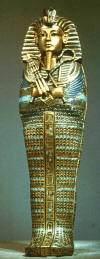|
Burial Room and Sarcophagus "The principal monument in
the collection is the enshrined body of the pharaoh himself.
The royal mummy reposed in the innermost of three coffins,
nested one within the other."
- Gardner's
Art Through The Ages,
11th edition, Vol. I, p. 71

****************************************************
Tut Ank Amon's
Outer Coffin

***************************************************
Tut Ank Amon's
Middle Coffin

****************************************************
Tut Ank Amon's
Inner Coffin
"The innermost coffin was
the most luxurious of the three. Made of beaten gold
(about a quarter ton of it) and inlaid with such
semiprecious stones as lapis lazuli, turquoise, and
carnelian, it is a supreme monument to the scupltor's and
goldsmith's crafts."
- Gardner's
Art Through The Ages,
11th edition, Vol. I, pp. 71

*************************************************
Tut Ank Amon's Gold Mask
"The portrait mask, which
covered the king's face, is also made of gold with inlaid
semi-precious stones. It is a sensitive portrayal of
the serene adolescent king dressed in official regalia,
including the nemes headdress and false beard. The
general effects of the mask and of the tomb treasures as a
whole are of grandeur and richness expressive of Egyptian
power. One can scarcely imagine what kinds of luxury
goods were buried with the truly important pharaohs."
- Gardner's
Art Through The Ages,
11th edition, Vol. I, p. 73

***************************************************
An Organ Vessel (Canopic Jar)

***************************************************
Annubis on a Shrine

***************************************************
Ostrich-Feather Fan

***************************************************
Tut Ank Amon's
Throne

***************************************************
War Chest
"Although Tutankhamen
probably was considered too young to fight, his position as
king required that he be represented as a conqueror.
He is shown as such in the panels of a painted chest
deposited in his tomb. The lid panel shows the king as
a successful hunter pursuing droves of fleeing animals in
the desert, and the side panel shows him as a great warrior.
... From a war chariot drawn by spirited, plumed horses,
Tutankhamen, shown larger than all the other figures on the
chest, draws his bow against a cluster of bearded Asian
enemies, who fall in confusion before him. He slays
the enemy, like game, in great numbers. Behind
Tutankhamen are three tiers of undersized war chariots,
which serve to magnify the king's figure and to increase the
count of his warriors. The themes are traditional, but
the fluid, curvilinear forms are features reminiscent of the
Amarna style. So are the artist's dynamic
compositions, with their emphasis on movement and action."
- Gardner's
Art Through The Ages,
11th edition, Vol. I, p. 73

|